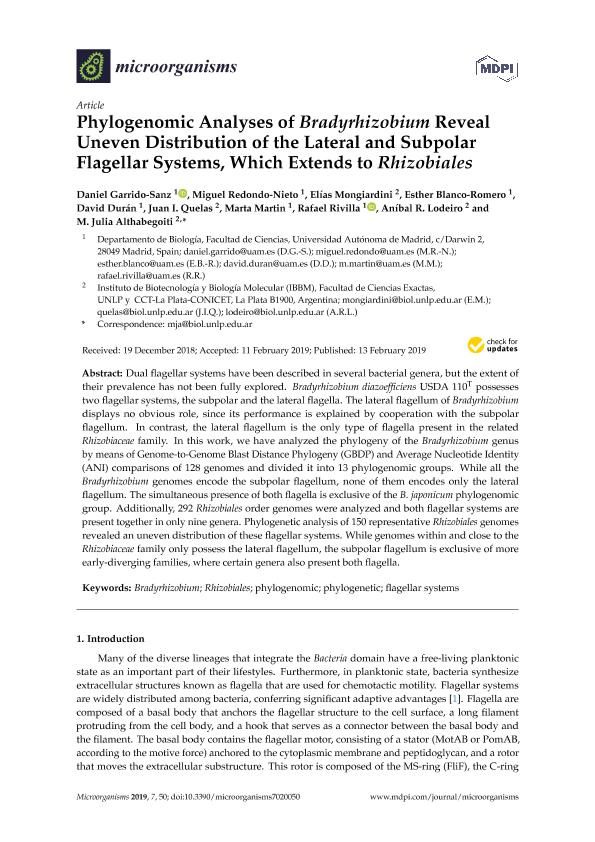Mostrar el registro sencillo del ítem
dc.contributor.author
Garrido Sanz, Daniel
dc.contributor.author
Redondo Nieto, Miguel
dc.contributor.author
Mongiardini, Elias Javier

dc.contributor.author
Blanco Romero, Esther
dc.contributor.author
Durán, David
dc.contributor.author
Quelas, Juan Ignacio

dc.contributor.author
Martin, Marta
dc.contributor.author
Rivilla, Rafael
dc.contributor.author
Lodeiro, Anibal

dc.contributor.author
Althabegoiti, Maria Julia

dc.date.available
2022-02-10T21:58:21Z
dc.date.issued
2019-02-13
dc.identifier.citation
Garrido Sanz, Daniel; Redondo Nieto, Miguel; Mongiardini, Elias Javier; Blanco Romero, Esther; Durán, David; et al.; Phylogenomic analyses of bradyrhizobium reveal uneven distribution of the lateral and subpolar flagellar systems, which extends to rhizobiales; MDPI AG; Microorganisms; 7; 2; 13-2-2019; 1-17
dc.identifier.issn
2076-2607
dc.identifier.uri
http://hdl.handle.net/11336/151810
dc.description.abstract
Dual flagellar systems have been described in several bacterial genera, but the extent of their prevalence has not been fully explored. Bradyrhizobium diazoefficiens USDA 110T possesses two flagellar systems, the subpolar and the lateral flagella. The lateral flagellum of Bradyrhizobium displays no obvious role, since its performance is explained by cooperation with the subpolar flagellum. In contrast, the lateral flagellum is the only type of flagella present in the related Rhizobiaceae family. In this work, we have analyzed the phylogeny of the Bradyrhizobium genus by means of Genome-to-Genome Blast Distance Phylogeny (GBDP) and Average Nucleotide Identity (ANI) comparisons of 128 genomes and divided it into 13 phylogenomic groups. While all the Bradyrhizobium genomes encode the subpolar flagellum, none of them encodes only the lateral flagellum. The simultaneous presence of both flagella is exclusive of the B. japonicum phylogenomic group. Additionally, 292 Rhizobiales order genomes were analyzed and both flagellar systems are present together in only nine genera. Phylogenetic analysis of 150 representative Rhizobiales genomes revealed an uneven distribution of these flagellar systems. While genomes within and close to the Rhizobiaceae family only possess the lateral flagellum, the subpolar flagellum is exclusive of more early-diverging families, where certain genera also present both flagella.
dc.format
application/pdf
dc.language.iso
eng
dc.publisher
MDPI AG
dc.rights
info:eu-repo/semantics/openAccess
dc.rights.uri
https://creativecommons.org/licenses/by/2.5/ar/
dc.subject
BRADYRHIZOBIUM
dc.subject
FLAGELLAR SYSTEMS
dc.subject
PHYLOGENETIC
dc.subject
PHYLOGENOMIC
dc.subject
RHIZOBIALES
dc.subject.classification
Biología Celular, Microbiología

dc.subject.classification
Ciencias Biológicas

dc.subject.classification
CIENCIAS NATURALES Y EXACTAS

dc.title
Phylogenomic analyses of bradyrhizobium reveal uneven distribution of the lateral and subpolar flagellar systems, which extends to rhizobiales
dc.type
info:eu-repo/semantics/article
dc.type
info:ar-repo/semantics/artículo
dc.type
info:eu-repo/semantics/publishedVersion
dc.date.updated
2020-11-16T20:38:40Z
dc.journal.volume
7
dc.journal.number
2
dc.journal.pagination
1-17
dc.journal.pais
Suiza

dc.journal.ciudad
Basel
dc.description.fil
Fil: Garrido Sanz, Daniel. Universidad Autónoma de Madrid. Facultad de Ciencias. Departamento de Biología; España
dc.description.fil
Fil: Redondo Nieto, Miguel. Universidad Autónoma de Madrid. Facultad de Ciencias. Departamento de Biología; España
dc.description.fil
Fil: Mongiardini, Elias Javier. Consejo Nacional de Investigaciones Científicas y Técnicas. Centro Científico Tecnológico Conicet - La Plata. Instituto de Biotecnología y Biología Molecular. Universidad Nacional de La Plata. Facultad de Ciencias Exactas. Instituto de Biotecnología y Biología Molecular; Argentina
dc.description.fil
Fil: Blanco Romero, Esther. Universidad Autónoma de Madrid. Facultad de Ciencias. Departamento de Biología; España
dc.description.fil
Fil: Durán, David. Universidad Autónoma de Madrid. Facultad de Ciencias. Departamento de Biología; España
dc.description.fil
Fil: Quelas, Juan Ignacio. Consejo Nacional de Investigaciones Científicas y Técnicas. Centro Científico Tecnológico Conicet - La Plata. Instituto de Biotecnología y Biología Molecular. Universidad Nacional de La Plata. Facultad de Ciencias Exactas. Instituto de Biotecnología y Biología Molecular; Argentina
dc.description.fil
Fil: Martin, Marta. Universidad Autónoma de Madrid. Facultad de Ciencias. Departamento de Biología; España
dc.description.fil
Fil: Rivilla, Rafael. Universidad Autónoma de Madrid. Facultad de Ciencias. Departamento de Biología; España
dc.description.fil
Fil: Lodeiro, Anibal. Consejo Nacional de Investigaciones Científicas y Técnicas. Centro Científico Tecnológico Conicet - La Plata. Instituto de Biotecnología y Biología Molecular. Universidad Nacional de La Plata. Facultad de Ciencias Exactas. Instituto de Biotecnología y Biología Molecular; Argentina
dc.description.fil
Fil: Althabegoiti, Maria Julia. Consejo Nacional de Investigaciones Científicas y Técnicas. Centro Científico Tecnológico Conicet - La Plata. Instituto de Biotecnología y Biología Molecular. Universidad Nacional de La Plata. Facultad de Ciencias Exactas. Instituto de Biotecnología y Biología Molecular; Argentina
dc.journal.title
Microorganisms
dc.relation.alternativeid
info:eu-repo/semantics/altIdentifier/url/http://www.mdpi.com/2076-2607/7/2/50
dc.relation.alternativeid
info:eu-repo/semantics/altIdentifier/doi/http://dx.doi.org/10.3390/microorganisms7020050
Archivos asociados
